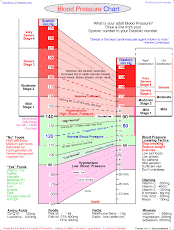Why are blood pressure readings important? Just what is "blood pressure"? Blood pressure is the force of the blood pushing against the side of it's container, the blood vessel wall. The higher number or the systolic pressure as it is called, is the maximum pressure on the artery, the diastolic pressure is the elastic recoil or resting pressure that the blood exerts constantly in between each heart contraction. Blood pressure readings are determined by the use of a piece of equipment called a sphygmomanometer which is used with a stethoscope. There are many different kinds available for people to use at home.
Measurement of blood pressure provides important information about circulatory function. It is an invaluable tool to use when making assessments related to cardiovascular health or when making determinations in fluid balance management.
How high is too high? What is a hypertensive emergency? To determine an individuals accurate blood pressure reading the blood pressure needs to be taken three different times on three different occasions.
Dr. Nathan J. Smith, M.D., agrees that limitation of sports participation is not warranted for individuals with mild hypertension. At the present time the level of systolic blood pressure that constitues a contraindication to strenuous competion is not known, but it is probably in the range of a systolic reading of 230 to 250 mm Hg.(Sports Medicine: Health Care for Young Athletes; 1983)
When are a series of high blood pressure readings an emergency? A hypertensive emergency is defined as increases in arterial pressure that if sustained for a few hours could cause irreversible organ damange. (some causes of a hypertensive emergency are: left ventricle failure, unstable angina/myocardial infarction, arortic dissection or cerebral hemorrhage.) Maglignant hypertension is defined as severe hypertension with a diastolic blood pressure usually greater than 130 mm Hg with retinal hemorrahages. A treatment which resulted in too rapid a decrease in the blood pressure would have negative effects on the patient.(The Handbook of Dialysis; Todd s. Ing; Lippincott 2001.)
A regular exercise program may lower blood pressure in individuals who already have elevated blood pressure of a systolic reading of over 165 and a diastolic reading of over 100.(Fitness Theory and practice by Peggy Jordan, RN. Aerobics Fittness of America; 1995)
Taking blood pressure readings as well as monitoring pulse rates are excellant methods of guaging the level and speed at which the vessels and heart are returning to acceptible levels. Increasing exercise activities yield a proportionate increase in blood pressure. Within 5 minutes of terminating the exercise, the blood pressure readings normally returns to the baseline figures.(Burch and DePasquale, 1962.)
Notes on aging: The aorta and major arteries begin to harden with age as the heart pumps against a stiffer aorta, the sytolic pressure increases. With many older people both the systolic and diastolic pressures increase so much so that it may be difficult to distinquish normal aging values from abnormal hypertension.(Physical Examination and Health Assessment; Carol Javis; W. B. Saunders Co. ;1992)
Cardiac output and strength of contraction decrease, thus lessen the older persons activity tolerance. The heart rate returns to its resting rate more slowly after exertion than it did when the individual was younger. Sudden emotional and physical stresses may result in cardiac arrhythmias and heart failure. (Fundamentals of Nursing; 1994)
Thursday, March 26, 2009
Subscribe to:
Post Comments (Atom)


Thank you for sharing your knowledge about sports medicine , nyc. I'm sure many athletes would be glad to come across this post.
ReplyDeleteBlood Pressure Is A Problem of Many Peoples Nowadays.. Blood Balance Advance Formula Helps To Get Rid Of Blood Pressure.
ReplyDelete